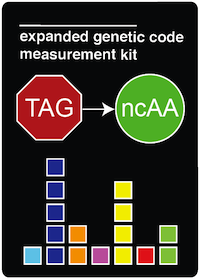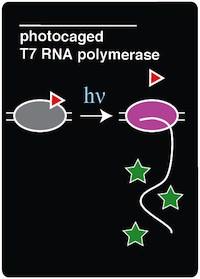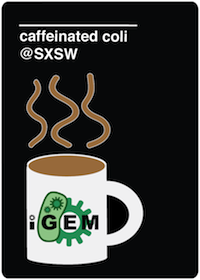Team:Austin Texas
From 2014.igem.org
| Line 85: | Line 85: | ||
| <h1>Project: Photocaged T7 RNA Polymerase</h1> | | <h1>Project: Photocaged T7 RNA Polymerase</h1> | ||
| - | Amino acids not included in the native 20 are commonly known as noncanonical amino acids (ncAAs). These ncAAs have unique chemistry that can provide very useful functionality not normally present in an organism. This summer we used a photocaged ncAA, ortho-nitrobenzyl tyrosine (ONBY), to prevent protein functionality until spatially and/or temporally triggered. To this end, our team recreated a light-activatable T7 RNA Polymerase (RNAP) for a method of noninvasive, spaciotemporal control of protein expression. We chose T7 RNAP because there is tyrosine residue in the active site of the polymerase. By changing this codon to an amber codon, we were able to incorporate (ONBY), a photocaged tyrosine, into the active site. The presence of the extra ONB group inhibits T7 RNAP activity. When exposed to 365 nm light, the molecular cage (the ONB group) is released, leaving tyrosine. Thus, T7 RNAP is only functional when exposed to 365 light, which restores the native T7 polymerase active site that is necessary for proper function of the enzyme. Once decaged, the polymerase transcribes sequences that are preceded by a T7 promoter. To test this system, we used a GFP reporter with a T7 promoter to analyze spaciotemporal specificity of photo-activation in living cells growing in media. We also attempted to photocage GFP. However, while the signal seen in live cells with decaged T7 RNAP was quite strong, we could not detect decaged GFP in living cells. This is likely due to the amplifying effect of decaging a single molecule of T7 RNAP relative to de-caging a single molecule of GFP. | + | Amino acids not included in the native 20 are commonly known as noncanonical amino acids (ncAAs). These ncAAs have unique chemistry that can provide very useful functionality not normally present in an organism. This summer we used a photocaged ncAA, ortho-nitrobenzyl tyrosine (ONBY), to prevent protein functionality until spatially and/or temporally triggered. To this end, our team recreated a light-activatable T7 RNA Polymerase (RNAP) for a method of noninvasive, spaciotemporal control of protein expression. We chose T7 RNAP because there is a tyrosine residue in the active site of the polymerase. By changing this codon to an amber codon, we were able to incorporate (ONBY), a photocaged tyrosine, into the active site. The presence of the extra ONB group inhibits T7 RNAP activity. When exposed to 365 nm light, the molecular cage (the ONB group) is released, leaving tyrosine. Thus, T7 RNAP is only functional when exposed to 365 light, which restores the native T7 polymerase active site that is necessary for proper function of the enzyme. Once decaged, the polymerase transcribes sequences that are preceded by a T7 promoter. To test this system, we used a GFP reporter with a T7 promoter to analyze spaciotemporal specificity of photo-activation in living cells growing in media. We also attempted to photocage GFP. However, while the signal seen in live cells with decaged T7 RNAP was quite strong, we could not detect decaged GFP in living cells. This is likely due to the amplifying effect of decaging a single molecule of T7 RNAP relative to de-caging a single molecule of GFP. |
|- valign="top" | |- valign="top" | ||
| | | | ||
Revision as of 14:49, 17 October 2014
| |||||||||||||||||||||||||||||||||||
 "
"




